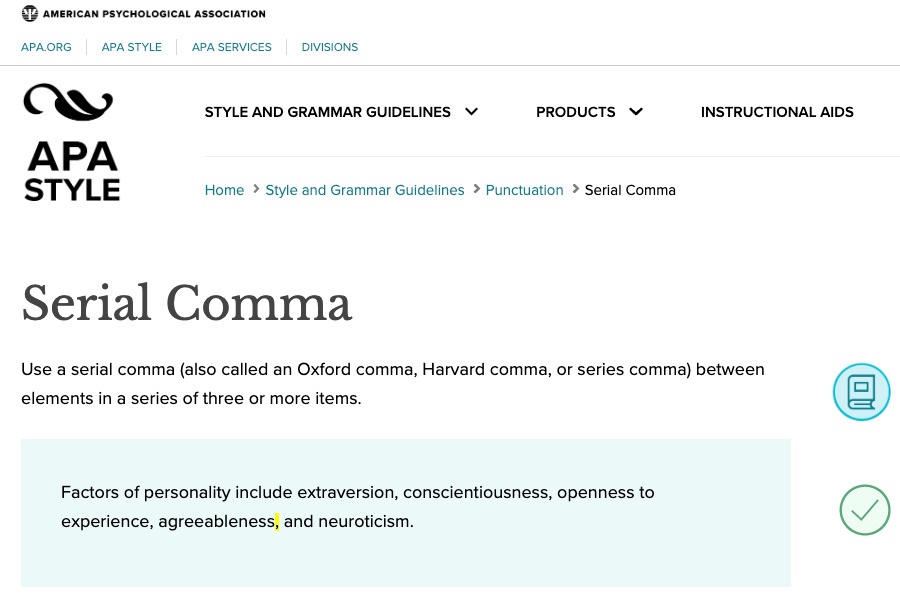Have you been wondering why the heck the Oxford comma keeps popping up in heated debates?
What is up with all this talk about an insignificant squiggly line?
Believe it or not, the Oxford comma (or Harvard comma) has been the cause of countless fall-outs, and has even changed the course of the law!
Turns out this simple comma is crucial knowledge.
In this post you’ll find out why it’s important, and how to use it to avoid misinterpretation.
And we’ll even have you chuckling with some fun examples.
Let’s dive straight in!

What Is The Oxford Comma?
The Oxford comma, classed as a serial comma, is the final comma in a list of three or more items.
The comma goes just before the “and” or “or” (called conjunctions).
Funnily enough, although it’s much more common in American English vs British English, the Oxford comma got its name from the Oxford University Press. In the United States it’s the Harvard University Press that gives this serial comma its name.
It looks like this:
“Mary called her sister, her friend, and her business partner.”
Simple enough, right? You’d think so….
But the Oxford comma is the subject of passionate literary feuds between different schools of style.
Here’s why.
The Curious Case of The Oxford Comma

This puny little punctuation mark (or the lack of it) lost Oakhurst Dairy, in Maine, $5 million in an overtime dispute! All over a missing serial comma after the word “shipment”.
Turns out, a sentence can take on vastly different meanings depending on the presence or absence of the Oxford comma.
But not everyone agrees on its use.
Why Some Say Yes
Let’s showcase this by removing the Oxford comma from the earlier example:
“Mary called her sister, her friend and her business partner.”
Is Mary calling three separate people? Or is her sister, friend, and business partner one person?
This ambiguity is precisely why many argue for the use of the Oxford comma:
- It improves clarity
- It improves precision.
Why Some Say No
Check out this sentence and then tell me what you think:
“Jeff, a semicolon, and a oxford comma walk into a bar.”
(they both had a great time)
Hahaa!! Not so easy, is it?!
The second sentence tells us that Jeff is, in fact, a semicolon. But without it, we wouldn’t know.
Thus, the Oxford comma, too, can cause confusion (alas!).
In case you’re interested, in this example, the comma is a different literary device called an appositive.
This confusion is why many grammarians oppose the Oxford comma. They also add that it‘s excessive and pompous.
Both teams have a point, so…
Is The Oxford Comma Correct Then?
Is the Mona Lisa beautiful?
Is Marmite a delicious spread or an inhuman abomination?
There is no hard and fast answer to any of these questions.
As for the Oxford comma, some say it should always be used, some say never, and then there are the agnostics.
The answer?
It isn’t incorrect, but it’s often unnecessary.
The important thing is to write clearly so that the reader interprets the message correctly. This can be achieved in different ways.
Hence the debate.
So, where does each official style guide stand in the Oxford comma war?
APA Style

The American Psychological Association (APA) states that the Oxford Comma should always be used. They argue that using it consistently reduces ambiguity and makes lists more clear.
AP Style
The Associated Press Stylebook doesn’t ban the use of the Oxford Comma, but the extra comma takes up valuable space on newspaper tabloids, so they recommend avoiding it (unless it helps clarify the sentence).
AP style is common amongst journalists and communicators.
Chicago Style Guide
The Chicago manual of style requires the use of the Oxford comma, or at least strongly recommends it. As per the APA style, they believe using it consistently helps the reader understand that when it isn’t there, it’s for a reason.
Chicago style is the most common for books and magazines, and is often used in business.
MLA Style
The Modern Language Association (MLA) style manual advocates the consistent use of the Oxford comma.
The MLA style manual is used mostly by academics in the humanities. If writing a research paper this is the most common style.
Now let’s see some Oxford commas in action.
7 Hilarious Oxford Comma Examples

We’ve handpicked the best examples of Oxford-comical blunders we could find so we can have ourselves a laugh-and-learn session.
“The country-and-western singer was joined onstage by his two ex-wives, Kris Krisofferson and Waylon Jennings.”
Excuse me?
The missing Oxford comma before the final conjunction “and” might conjure up an image of a cowboy standing with his ex-wives Kris Kristofferson and Waylon Jennings…
Not impossible, but yikes! Probably not what the writer meant.
Most likely four people joined the singer — 2 ex-wives plus Kris, plus Waylon.
“How Harry Reid, a terrorist interrogator and the singer from Blink-182 took UFOs mainstream.”
It appears Harry Reid has taken on a few new identities here — extremely disparaging ones too.
If you didn’t know who Harry Reid was (which, most non-US readers wouldn’t), you might think he indeed was a ruthless interrogator, singer, and had something to do with UFOs.
Obviously, if you know who he is, that makes no sense.
This example brings us to a key point about the Oxford comma:
Lists containing items the reader may not be familiar with benefit more from using it.
Without the Oxford comma, you need to know the context of the sentence to understand its intended meaning.
“I love my parents, Lady Gaga and Humpty Dumpty.”
OK I’m going to give you a moment to allow you to picture this poor child…
Mmm…was this person a Picasso-style minotaur with Lady Gaga’s beautiful face and the egg-shaped body of Humpty Dumpty?
Though more fun, my guess is the author meant something quite different… or did she?
Add an Oxford comma before the “and” and you wouldn’t have to sit there wondering!
“… now that he is an overworked employee at the Ministry of Magic, a husband and father of three school-age children.”
Apologies for the mental imagery!
OK, OK, of course the authors of this Harry Potter book didn’t mean that Harry is married to the children. But without the Oxford comma, that macabre possibility exists.
Oddly the Harry Potter series is riddled with examples of dubious grammar – yet it’s one of the most successful book series of all time.
Moral of the story?
Grammar can be very important but good storytelling trumps perfection.
“In class today you’ll play with the frogs, Jason and Mia.”
Interesting names for a couple of frogs, right?
It looks like this school-goer’s going to have a blast today…
Once again, if the reader knows who Jason and Mia are, there’s probably no need for an Oxford comma in this example. But for the rest of us, the question remains whether Jason and Mia are frogs, or not.
“I am going to England to see my parents, Elton John and Queen Elizabeth.”
Sir Elton does have 2 beautiful children but they most certainly are NOT Queen Elizabeth’s!
OK, maybe this example is a little silly hahaha!
The pattern’s the same as in the previous examples… yet you wouldn’t really believe that Elton John and Queen Elizabeth had a child together.
But why?
Because of context. We know who they are. We know they wouldn’t have that type of relationship. So I guess it’s OK to skip the Oxford comma in this case.
But if your reader doesn’t know the context, you want to be more careful!
“Attention: Toilet ONLY for disabled, children, elderly and pregnant.”
OK this one is just too much for me. I love these badly-written signs.
It’s not the first funny mistranslation to hit viral levels, but how can we fix it?
Unless they do mean elderly and pregnant are the same group of people, adding an Oxford comma would make this sign much clearer!
Why Should I Care About the Oxford Comma?

If you want your writing to be interpreted correctly, you need to take a stance on the Oxford comma.
Otherwise, you risk confusing the reader and creating a problem that might have dire consequences (ask Oakhurst Dairy).
If you’re writing for someone else, check their style guide, and follow it.
If you decide to wing it, consider the context. Use the Oxford comma when it adds clarity to the sentence.
And if you can’t deal with all the grammar decision-making, pick yes or no and stick to your guns.
One thing’s for sure — no matter what you decide, someone’s going to disagree!



